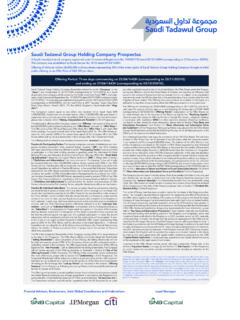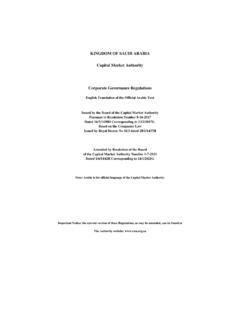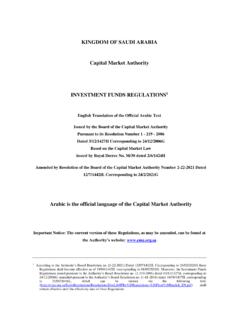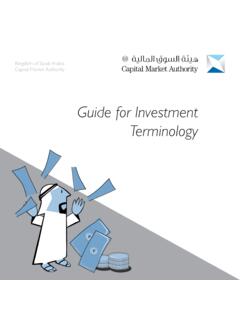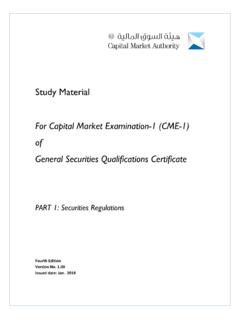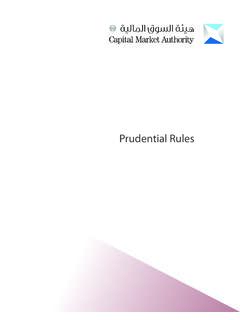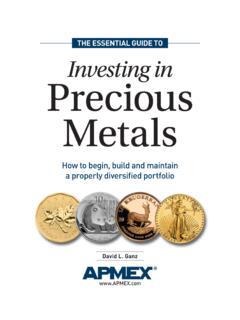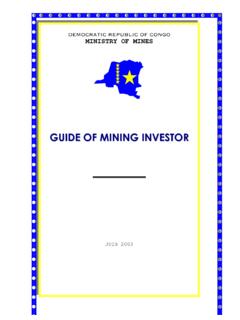Transcription of Guide or Yf oung Investors
1 Kingdom of Saudi ArabiaCapital Market AuthorityGuide for YoungInvestorsIntroductionInvesting can be a satisfying way to increase your fortune and help you achieve your financial goals. However, it is essential to make wise investment choices and avoid risk, such as buying and selling stocks based on tips and rumors or investing all your money in one field of investment. Your objective is to continually accumulate more assets, not lose the ones you booklet provides an overview on investing. It explains how to choose investments, how to evaluate their performance, especially Investment Portfolios and how to manage your portfolio to seek the best return. The booklet also discusses the different types of investment risks and the strategies for limiting those risks, as well as how to learn to make good decisions, avoid common mistakes, and take advantage of the benefits of : An Overview of the Foundations of Investment Why Do We Invest?
2 While you might not have the money to af-ford the things you want, making good invest-ments can help you in accumulating what you need over time. For example, by investing you can: Enhance your wealth. Provide income. Meet your short- and mid- term goals, such as a new PC, a car, or other items. Meet your long-term goals, such as buy-ing a new home or securing your future when you are set to can also protect you from inflation, which is the steady increase in the price of goods and services. It is known that Infla-tion leads to decrease the Riyal s value, which means you need more money every year to maintain the same standard of living. Accord-ing to the Saudi Arabian Monetary Agency, in-flation in the Kingdom has risen significantly in the recent people think that they are avoiding risk by saving money instead of investing.
3 But even though a bank account might keep your mon-ey safe, it won t allow your assets to grow at a rate that is high enough to offset inflation. So the value of your savings, measured as a buy-ing power, will steadily decrease. However, if your investment portfolio gives you a return that is greater than 7% ( as an inflation rate for example) you will be able to preserve your wealth and increase your buying power. If your investments provide an average return of 10%, you will stay ahead of inflation and also start to build your wealth. Gaining ProfitsUnlike inflation, increased profits allow you to use time for your advantage to steadily increase the value of your investments. Your 3money multiplies when you reinvest your earnings, or buy more shares with the money you make from your investments.
4 When you add your earnings to your investment account, you increase the size of your capital, which in turn can increase the amount of your example, if you invested 20,000 Riyals in a stock that had a return of 9% each year for five years, and reinvested your dividends eachyear, your stock would not just gain 1,800 Ri-yals every year (9% of 20,000), but its actual growth would look like this: Your initial investment would have gained about 54% of its original Riyals1st Year Balance:1800 Riyals+ 1st Year Riyals2nd Year Balance: 1962 Riyals+ 2nd Year Riyals3rd Year Riyals+ 3rd Year Riyals4th Year Balance:2331 Riyals+4th Year Riyals5th Year Riyals+5th Year Earnings:30,772 Riyals Balance after 5 years4 Investment RiskIts known that there is no such thing as a risk free investment.
5 But understanding what causes the risk can help you create an invest-ment strategy to help protect against losses in your of the risks you may face as an inves-tor are the result of political uncertainty or a downturn in the global economy. Sometimes a downturn affects only the economy of a par-ticular region or country. In other cases, risk may be created by a slowdown within a par-ticular industry. You should always be aware that capital market products are higher in risk than other investment products. Loss of CapitalWhen you invest in an individual company, you can make or lose money depending on its performance. If the company s performance was good and made profits, your investment will usually gain value, and you might be paid dividends. On the other hand, if the company does not perform well, your investment could lose FluctuationOne of the investment risks is prices fluctua-tion or the possibility that the stock price may change in a short term.
6 The greater the prices fluctuate, the risk and ReturnRisk and return are directly related, which 5means that the greater the potential that an investment might lose money, the greater its potential revenue. One of the keys to suc-cessful investing is finding a way to balance risk and return in your investment : a Strategy to Reduce RiskSince different investments have different lev-els of risk, the best way to protect yourself is to vary your investments across different asset classes, such as stocks, Sukuk, and real estate. Also, you would want to diversify your investments among different companies from each type. The goal is to lower the risk and to protect your portfolio if there was a market your Risk ToleranceSome Investors are willing to take on risk more than others.
7 Your risk tolerance is gen-erally influenced by factors such as your age, your financial situation, or even your personal-ity. For example, some Investors have a greater tolerance for risk and are able to deal with losses of their investments. They may be will-ing to invest in companies where there is higher risk, but also a greater opportunity for return. More conservative Investors , however, are more comfortable with investments that do not pose a greater risk but do not have the same potential for higher tolerance may also change as your fi-nancial goals change, or as future goals ap-proach. For example, you may want to shift to less risky investments as you come within a few years of meeting certain goals. That way, if there is a sudden downturn in the market just when you need the money, you will not find yourself with less than what you planned 2: Financial PlanningTo manage your money effectively, you will need to have a financial plan.
8 A financial plan is a written statement of your financial goals and your strategies for achieving them. This plan includes: A summary of your current assets. A list of your primary goals and a time-frame for meeting them. An estimate of what you expect your goals will cost . A list of the types of investments you might make to help achieve those goals. A schedule for implementing those that Financial planning is an on-going process. You will want to evaluate your prog-ress on a regular basis, update your list of goals or your timetable, and revise your strategies as your goals or financial situation GoalsYou may have several different financial goals. They can be immediate and simple in the short or long term. The most helpful way to group your goals is usually by the time you have to meet GoalsAre those you hope to meet in the next year or two.
9 To invest for these goals, you want to keep your money secure and liquid, so you will have it available when you need it. You do not want to risk money intended for your short term goals on uncertain GoalsAre those you expect to achieve within ten years. These goals may include buying a home, starting a business, or paying for tuition. You can afford to take some risks when you invest for mid-term goals, especially if they are sev-eral years away. Due to time constraints, you may want to sell the riskier investments and put the money into a more secure GoalsAre more than ten years in the future. For most people, the primary long-term goal is affording a comfortable retirement. Helping your children or starting a business of your own may also be in this category.
10 As long as you are investing for growth, then you can usually afford to take more investment risks to meet your long-term AdviceMany people seek professional advice in mak-ing and implementing a financial plan. One ad-vantage of working with a professional is that it gives you an added incentive to get started and stay focused on your plan. You can ask friends or family members who are experienced Investors for referrals to the planning professionals they work with. You may also discuss your planning needs with the authorized person who handles your invest-ment transactions. 8 Part 3: How to Start InvestingMoney to InvestIn order to invest, you need an initial sum of money to buy those stocks. This is called your main capital. For example, to buy 100 shares of a stock priced at 35 Riyals per share, you need 3,500 Riyals plus enough money to pay the authorized person s fee.
